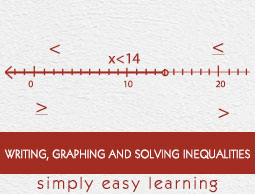
- Writing, Graphing and Solving Inequalities
- Home
- Translating a Sentence by Using an Inequality Symbol
- Translating a Sentence into a One-Step Inequality
- Introduction to Identifying Solutions to an Inequality
- Writing an Inequality for a Real-World Situation
- Graphing a Linear Inequality on the Number Line
- Writing an Inequality Given a Graph on the Number Line
- Identifying Solutions to a One-Step Linear Inequality
- Additive Property of Inequality with Whole Numbers
- Multiplicative Property of Inequality with Whole Numbers
- Solving a Two-Step Linear Inequality with Whole Numbers
- Solving a Word Problem Using a One-Step Linear Inequality
Solving a Word Problem Using a One-Step Linear Inequality
We have word problems based on real-world situations that can be modeled using one-step inequalities. The solutions of these problems usually have multiple answers over a range of values for which those inequalities are true.
Let us consider the following word problem examples and try to understand how to solve them and obtain the range of values for which these are true.
A contractor is purchasing some tiles for a new patio. Each tile costs $4 and he wants to spend less than $1200. Find the number of tiles he can buy with this amount.
Solution
Step 1:
Let the number of tiles he want to buy be x
Step 2:
Cost of each tile = $4
Cost of x tiles = 4 × x = 4x
Step 3:
Amount he can spend is ≤ $1200
So cost of tiles has to be less than or equal to $1200
4x ≤ 1200
Step 4:
Dividing both sides by 4
4x/4 ≤ 1200/4; x ≤ 300
So the solution of this inequality is
x ≤ 300; The contractor can buy a maximum of 300 tiles.
In 5 years, Sarah will be old enough to vote in an election. The minimum age for voting is at least 18 years. What can you say about how old she is now?
Solution
Step 1:
Let the age of Sarah be x
Step 2:
In 5 years, Sarah’s age = x + 5 which is at least 18 years
x + 5 ≥ 18
Step 3:
Subtracting 5 from both sides
x + 5 −5 ≥ 18 – 5; x ≥ 13
Step 4:
So she is at least 13 years or x ≥ 13